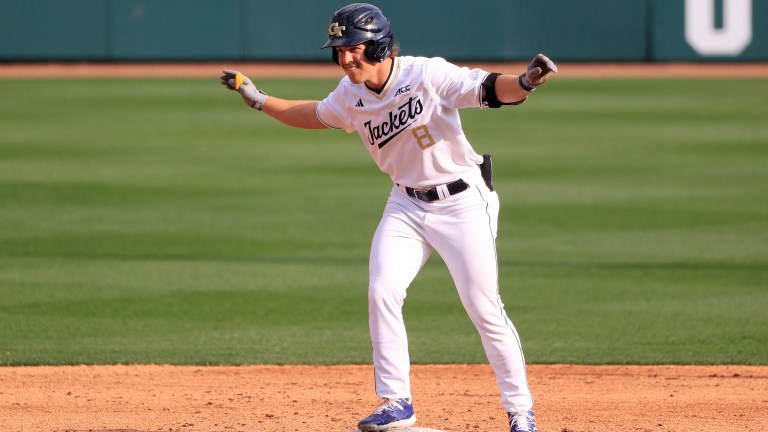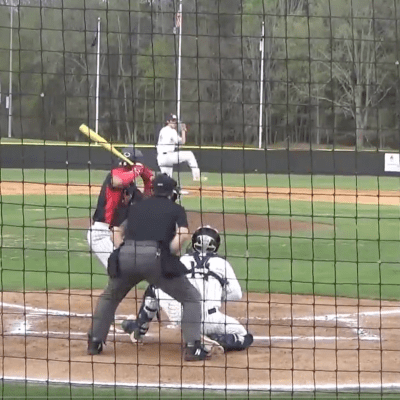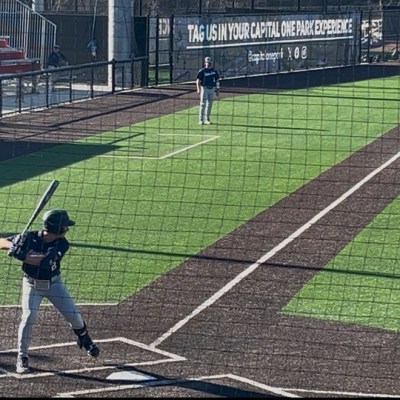2026 MLB Draft Showdown: Justin Lebron vs. Drew Burress vs. Roch Cholowsky. Who’s #1?!
Maybe it's too soon to start thinking about the first overall pick in the 2026 draft, but here we are.

Is it ever too early to start talking about a future draft class?! Never! I’m totally kidding. It might be too early to be talking about the No. 1 pick for the 2026 MLB Draft, but here we are.
The conversation has started to brew as Alabama’s Justin Lebron, Georgia Tech’s Drew Burress, and UCLA’s Roch Cholowsky have been creating headlines all season long, thanks to their performances on the field and the type of human beings they are off the field.
Lebron, Burress, and Cholowsky have been absolute staples in their lineups as sophomores, and all have shown some elite leadership traits.
All these players bring some similarities but also vastly different profiles to the table. Lebron is a twitchy, high-upside infielder with the tools to stick at shortstop long-term, while Burress is an undersized but ultra-productive hitter with a growing track record of success against elite competition. Cholowsky is a mix of elite defensive and plus-hit tools with burgeoning power.
The contrast in style, projection versus polish, creates a fascinating debate that could define the top of the 2026 class. It also dives into a fun ACC vs. SEC debate as Burress plays in the ACC and Lebron in the SEC.
Let’s dive in!
All stats, rankings, and standings are up to date as of April 9, 2025.
The Case for Justin Lebron
Lebron has taken off like a rocket ship in 2025. That’s not to say he had a bad 2024 as a freshman. On the contrary, he slashed .338/.429/.546 with 9 2B, 12 HR, and 37 RBI. What’s crazy is that he did that over an entire season and has already tied or surpassed each category in 2025.
A lean, athletic 6-foot-2 shortstop with above-average bat speed and elite defensive instincts, Lebron checks nearly every box scouts look for in a potential top-of-the-draft shortstop.
Through his sophomore campaign, he’s slashed .343/.442/737 with 10 doubles, a triple, 14 home runs, and 56 RBI (as of 4/9), showing flashes of developing power while maintaining strong plate discipline.
Under the hood, the metrics tell a compelling story about his increase in power. His 110.5 mph max exit velocity, 94th percentile average EV, and 54% hard-hit rate point to a player whose power ceiling is still climbing.
More importantly, his 14% chase rate underscores a disciplined approach that bodes well for continued growth against higher-level pitching.
The only negative on the offensive side is that he doesn’t walk at a high clip, although he’s at a 10% BB% right now, and he whiffs at a higher percentage than you’d like to see. Those are two areas that he should be able to improve on.
Defensively, he projects as a true shortstop at the next level, with plus range, instincts, and the internal clock to make tough plays look routine.
Lebron’s combination of defensive certainty, twitchy athleticism, and evolving power makes him one of the most complete and projectable players in the class. The upside is immense. He’s got an easy case to be the potential No. 1 overall pick in 2026!
The Case for Drew Burress
If Justin Lebron represents upside and projection, Drew Burress brings present-day production and polish.
The Georgia Tech outfielder has been one of the most dangerous bats in college baseball since he stepped on campus, pairing elite bat speed with an advanced approach that few peers can match.
In 2025, Burress is slashing .366/.485/.794 with 18 doubles, a triple, 12 home runs, 44 RBI, and eight stolen bases (as of 4/9) and more walks than strikeouts, underscoring just how complete his offensive profile is.
His underlying metrics are elite across the board: a 113.5 mph max exit velocity, 98th percentile average EV, and a 51% hard-hit rate make it clear his power is very real, regardless of his smaller frame.
He’s also an elite decision-maker in the box, posting a 17% walk rate and a 94th percentile chase rate, proving he doesn’t need to cheat to find damage.
While he’s more likely to settle into a corner outfield role long-term, Burress moves well enough to handle center in the short term and has an above-average arm to fit in right.
With one of the best pure bats in the country and the makeup of a high-floor impact hitter at the next level, Burress offers a compelling case to be the first name called in 2026, especially for teams prioritizing offensive certainty.
The Case for Roch Cholowsky
UCLA’s Roch Cholowsky has flown under the radar for the most part this year. Maybe call it East Coast bias? Who knows. But Roch deserves to be in this conversation.
Cholowsky has been the heartbeat at the top of this Bruins lineup. A steady, consistent producer who is putting up video game numbers himself.
As of April 9th, Cholowsky has put up a .371/.532/.707 slash line with 10 doubles, one triple, nine home runs, 32 RBI, and 27 walks to his 19 strikeouts in 32 games.
What’s even more impressive is what you can see under the hood of these outward-facing stats. Coming out of high school, the question was whether Cholowsky would develop into more power, and he is undoubtedly meeting those expectations.
He’s got a max exit velocity of 114.1 and an average exit velocity of 87.6 MPH. On top of that, he’s in the 96th percentile for hard-hit percentage. It’s been incredibly solid pull-side power.
And this has all come at no expense of his hit tool. He still can control the strike zone, find his pitch, and limit chasing out of the zone. It’s incredibly polished.
I caught him against Maryland, and what was even more impressive than the offensive profile was the defensive profile. He has silky smooth actions at shortstop and plus arm strength.
He also has quick reaction times and moves well to his left and right. He can use his quick reaction times and athleticism to get fly balls over his head, and he’s already made some spectacular catches like this.
The defensive prowess with the burgeoning hit tool and power makes Cholowsky one of the most intriguing players in a powerful 2026 MLB Draft class.
Other Factors That Will Go Into Determining the #1 Overall Pick
While talent and performance drive most of the conversation, the decision at 1-1 is rarely made in a vacuum. Several external factors could influence which player comes off the board first in 2026.
Organizational needs and draft philosophy often play a significant role. Some teams prioritize premium defensive positions and up-the-middle athleticism, which would favor a player like Justin Lebron.
Others may lean toward college bats with extensive offensive production and plate discipline track records, a mold Drew Burress fits perfectly.
Bonus demands and signability will also be critical, especially with the bonus pool system incentivizing strategic spending at the top.
A team looking to spread its money across multiple picks might prefer a player willing to sign under slot, potentially tipping the scales in either direction depending on how each camp approaches negotiations.
Injury history, summer showcase performance, and Statcast-driven scouting models are all becoming increasingly important in front offices.
Meanwhile, front offices relying more heavily on data models may gravitate toward the batted ball metrics, chase rates, and swing decisions both Lebron and Burress have already demonstrated.
Finally, the strength of the rest of the class, particularly on the pitching side, could play a role. If a college ace surges into elite territory, it could make the decision that much more difficult. It’s hard to see a prep arm reaching 1-1.
But if the field remains position player-heavy, the battle between Lebron, Burress, and Cholowsky could define the top of the draft until July 2026.
Conclusion
There is still so much that can happen between now and draft day in 2026. There is plenty of time for other names to pop up as we get closer to the 2026 MLB Draft.
We’re still over a year out, and so much can (and will) change between now and then. But if the early indicators mean anything, Justin Lebron, Roch Cholowsky, and Drew Burress are firmly in the driver’s seat to headline the class.
Whether it’s Lebron’s electric athleticism and shortstop profile or Burress’ and Cholowsky’s elite production and mature approach at the plate, all three players bring No. 1 pick-caliber resumes with plenty of time to strengthen their cases.
One thing’s for sure: This current three-horse race is worth watching to the finish line.


